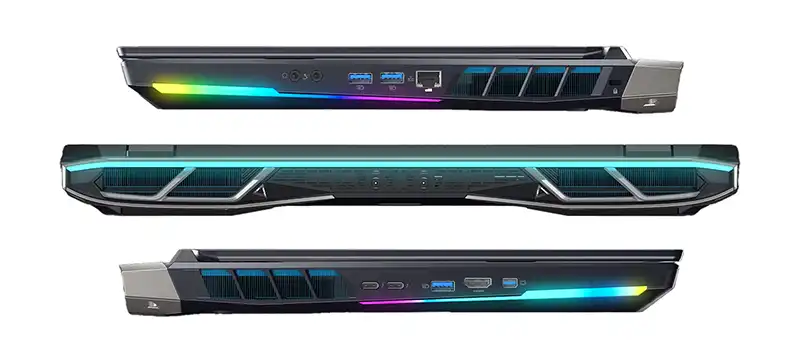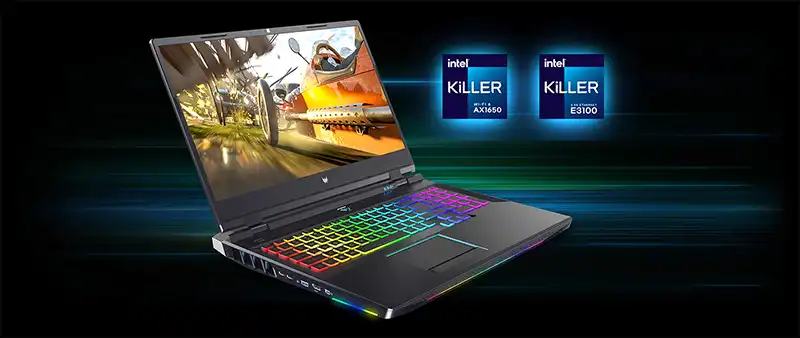You can also be interested in these:
- Acer Predator Connect X5 full review
- The Acer K243Y full review: The cheapest IPS monitor
- Asus ROG Zephyrus M16 GU604 2023 full review
- Razer Blade 16 gaming laptop full review
The Acer Predator Helios 500 is the latest generation that caters to the needs of the most demanding gamers and enthusiasts. With its 17-inch size and Pulsar Lighting illumination, this incredible version is as visually striking as it is massive. The flagship offers an Intel i9-11980HK processor, Nvidia RTX 3080 GPU, 32 GB of RAM, PCIe 4.0 RAID SSD, and an impressive dual-fan cooling system, making it a powerhouse for any gaming enthusiast. Moreover, the Mini LED 4K @120 Hz HDR 1000 technology implemented in the device’s display is one of the best gaming displays for laptops. It is exciting to see it in action.

Design specific for a gaming audience
The Acer Predator Helios 500 design seems to have gone against the trend of the Predator Triton series, which has become more discreet and elegant. It is presented in a more aggressive look by adding lighting accessories throughout the chassis. However, it still adopts the guidelines of the previous generation in terms of color, lid, and logo, as a sign of identity. The thick design of the laptop is noteworthy, with a thickness of 42 mm when closed and around 33 mm from its base when opened. The laptop’s thickness is meant to provide extra cooling and interior space instead of pursuing maximum thinness like most devices. The result is a performance that rivals that of a desktop computer.
Firstly, let’s examine the design, and what stands out is the Acer Predator Helios 500 brutal thickness. The laptop’s thickness is 42 mm when closed and around 33 mm from its base when opened, which is the opposite of most devices that aim for maximum thinness. Acer has opted for a thicker design to provide extra cooling and interior space to ensure performance that rivals that of a desktop computer. Secondly, the laptop’s design is more aggressive than the Predator Triton series, with lighting accessories throughout the chassis. Nonetheless, it maintains the previous generation’s guidelines in terms of color, lid, and logo, giving it an identity of its own.
The Acer Predator Helios 500 follows the standard measures of other 17-inch laptops, with a width of 400mm and a slightly longer depth of 320mm due to the rear extension. This is a common technique used by high-performance laptops to improve their aesthetics when opened and provide space for fans and air expulsion. In this case, the design has been taken to the extreme, with two large rounded grilles on each side that reveal the densely finned blocks with a chrome detail. The central area contains two Jack-type power outlets.
The rear of the Acer Predator Helios 500 resembles the diffusers of a Bugatti Chiron, with the strip of lighting covering the entire upper edge. This detail complements the RGB Predator logo placed in the center of the screen lid. The Mini LED 4K panel will be mounted on a high-quality, finished aluminum casing with a thickness of nearly 10mm to ensure maximum rigidity when opening and closing. When opening from the corners, there is no torsion, and the screen appears sturdy.
The screen of the Acer Predator Helios 500 is anchored with two large hinges at each end, raising it above the rear of the laptop. The hinges are frictionless and smooth, with just the right amount of hardness to maintain the desired position. The hinges have a protruding area of the same thickness where the hard disk, power, and charging activity indicator LEDs are located.
Moving on to the side areas, we come across the massive ventilation grilles and ports. These grilles are even larger than the ones at the rear. When the fans are at maximum performance, a high volume of air flows out of these openings. Due to the Pulsar Lighting system’s RGB lighting strips covering most of the front area from the grilles, there is limited space for ports.
With the front RGB strip, Acer’s lighting system is complete, covering a significant part of the available length. The Predator Sense software allows complete management of these RGB areas, which synchronize with the keyboard lighting. Audio synchronization has been added with four patterns, and there is even synchronization with the colors displayed on the screen through a new system called Mimic. The area remains semi-open due to a ventilation grille that covers the entire space.
Moving on to the bottom of the Acer Predator Helios 500, there is ample room for almost anything. The manufacturer has opted to open only the circular outlets of the two fans to concentrate the airflow. Further down, there are more openings in the form of gills to provide an outlet for the audio system, which has a subwoofer to enhance the bass. The area is completed with anti-slip rubber feet that raise the back of the laptop considerably to ensure proper air intake.

After opening the extensive screen, we arrive at the interior area of the Acer Predator Helios 500. The screen is installed on rigid plastic frames falling under Acer’s Slim-Bezel designation. The side frames measure 7 mm, the top edge 11 mm, and the bottom edge a massive 41 mm. Mini LED technology requires a little more space for hardware, but it still falls within the proportions of this enormous device. The webcam remains installed on the top edge along with the microphones.
Let’s start with the keyboard area, which provides ample space for a complete distribution that includes a NumPad. The keys are arranged in an island format with RGB lighting and illuminated edges. The keys remain at the level of the aluminum casing, with the directional keys having a prominent position for better use in games. However, we noticed some sinking in the central area of the keyboard, which is unexpected from such a robust laptop. Central anchors would have been a solution to prevent this sinking due to the wide area.
One thing that doesn’t quite meet our expectations is the sunken mouse trackpad in this model. It leaves an uncomfortable edge of almost 2 mm when we reach the end of the touch area, even with the blue lighting frame placed around it. It could have been raised to the surface for a better user experience. However, being a gaming touchpad, the buttons are independently placed with higher quality switches, a slightly wider travel, and soft touch.
Ports and connectivity
Let’s move on to the connectivity of the Acer Predator Helios 500, which is quite impressive. The ports are distributed on both sides, with the charging ports located at the back. The side areas have huge ventilation grilles and ports, which are even larger than the rear ones. The front area has more RGB lighting strips from the Pulsar Lighting system, covering the entire area from the grilles. Despite the lack of space for ports, the manufacturer has managed to provide a wide range of connectivity options.
On the right side, we have a 2.5 Gbps RJ45 LAN Ethernet port, 2 USB 3.2 Gen2 Type-A ports, and 2 audio output and microphone input jacks. There’s also a Kensington slot for universal locks. On the left side, we have 2 USB4 Type-C ports with Thunderbolt 4, 1 USB 3.2 Gen2 Type-A port, an HDMI 2.1 port, and a Mini DisplayPort 1.4. The Thunderbolt 4 ports support Power Delivery of up to 100W for laptop charging and DisplayPort 1.4 for multiple monitor output at 4K @60 Hz. The dedicated GPU also supports an HDMI 2.1 port for 8K displays.

The Acer Predator Helios 500 also has powerful Killer LAN chips with 2.5 Gbps and Killer AX1650i Wi-Fi 6 WLAN for network connectivity. These are the gaming variants of Intel’s cards and come with the Killer Control Center that allows for load balancing, bandwidth management, and more from Windows. The Wi-Fi 6 card has the same bandwidth as all other Wi-Fi 6 laptop cards, with 2.4 Gbps for 5 GHz and 574 Mbps for 2.4 GHz in 2×2 connections. While the laptop doesn’t support Wi-Fi 6E, the network connectivity is still impressive.
Furthermore, the device can be equipped with a 5G modem to enhance its connectivity and mobility by adopting LTE, although it is not included in the review model. Nevertheless, TPM 2.0 has been implemented in this case to ensure maximum compatibility with Windows 11.
Gaming display and Mini-LED technology
The Acer Predator Helios 500 sets a new standard for 17-inch displays and stands out as one of the laptops with the best panel in the market. It doesn’t settle for the new 360Hz FHD or 165Hz QHD panels, but instead uses Mini LED technology with a 4K resolution (3840x2160p).
Mini-LED technology enhances IPS-based panels with a new, more powerful backlight system. This laptop’s Mini LED technology has 512 zones of dynamic local dimming, which significantly improves the contrast to approach what an OLED panel offers. Additionally, it is VESA DisplayHDR 1000 certified and covers 100% of DCI-P3 colors, making it suitable for professional design tasks.
Despite its impressive features for professional tasks, it’s a gaming laptop that boasts a 120Hz refresh rate and a minimum response time of 3ms. These are remarkable figures for a 4K panel of this type, especially considering the HDMI 2.1 interface’s bandwidth capabilities. Although there is no noticeable tearing on the screen, we assume it incorporates Adaptive Sync technology, but G-Sync is not available in the Nvidia control panel.
Having examined the panel’s characteristics, it is safe to say that the image quality is impressive, and the sharpness and desktop real estate it offers are amazing. Moreover, the image quality remains consistent at 178 degrees both vertically and horizontally, only losing a bit of brightness, which is normal. It is a worthy professional desktop monitor, but this time integrated into a laptop.
Sound system
The Acer Predator Helios 500 comes with a sound system that includes speakers with a subwoofer at the bottom, producing good audio quality. Furthermore, it incorporates DTS:X Ultra technology, which allows it to generate virtual 360-degree surround sound.
Whether or not it’s surround sound, the system offers a high level of audio quality, outperforming many of its competitors due to its high maximum volume and the abundance of nuances it can deliver. The subwoofer provides a slight boost in bass power that we will especially enjoy in movies and games, but it’s not excessive.
Moreover, the speakers are more widely spaced due to the laptop’s large size, and there is better resonance due to its thickness. In short, it’s one of the best integrated sound systems we can find on a laptop, and Acer has done an excellent job of upgrading it to maintain its high level.
The Realtek codec installed on the Acer Predator Helios 500 provides impeccable quality in the side 3.5mm Jack output, which is dedicated to gaming headphones or speakers. The pre-installed DTS:X application allows us to modify the audio profile of both internal and external speakers to our preference.
The webcam sensor on the Acer Predator Helios 500 is capable of taking photos and recording at 1920x1080p @ 30 FPS. As seen in the screenshot, it provides excellent image quality suitable for live streaming while gaming, making it an ideal standard for new generation laptops. The microphone array offers clear far-field recording, although a desktop microphone is preferable for streaming. However, the set does not support facial recognition, which is highly recommended at this point, especially with the imminent update to Windows 11.
Gaming keyboard
The peripheral configuration of the Acer Predator Helios 500 is extensively updated to offer the best possible gaming performance while maintaining a membrane key system except for the WASD package, making the keyboard area an important section in this analysis.
We had the opportunity to test the keyboard configuration of the Acer Predator Helios 500, which has been updated to provide an optimal gaming experience while maintaining a membrane key system, with the exception of the WASD package. The unit we reviewed had an ANSI-type layout, but a Spanish version will be available when it is released in our market. Since there is ample space, the keyboard includes a full NumPad and allows for good separation between keys and different regions. As a result, we have a separate set of arrow keys to improve usability and a separate row of F keys.
The island-type layout features smooth, 15 x 15 mm keycaps with good grip, and backlighting on the characters and edges. Most keys use a membrane system with an approximate travel of 3mm, which is higher than keys from other brands, such as Asus or Steel Series. This makes typing feel excellent, with a smooth travel, low noise, and very little actuation force. It’s been a real pleasure typing on this keyboard while writing this review.
The keyboard of the Acer Predator Helios 500 has a Per-Key RGB lighting system, allowing us to customize the lighting of each key individually. This system can be synchronized with the laptop’s edge lighting, as well as what is displayed on the screen, thanks to the Mimic function. This effect is quite original, especially for gaming, as the lighting will respond to the colors on the screen to generate greater immersion.
The WASD package, as well as the directional keys, feature MagTek linear analog mechanical switches, which allow us to gradually increase the pressure on the key and have it function as a joystick. The range of travel from initial activation at 0.8 mm extends up to 3.1 mm, and we can customize their activation point from 1 to 3 mm depending on our preferences using Predator Sense. The bundle also includes concave keycaps for these keys, providing a better touch and gaming experience. They are easy to interchange as they have a magnetic coupling. Apart from that, we have a shortcut key to the brand’s software, as well as a manual turbo mode button for the cooling system.
In conclusion, the keyboard of the Acer Predator Helios 500 is excellent, offering a comfortable typing experience with responsive keys and customizable RGB lighting. The inclusion of MagTek linear analog mechanical switches for the WASD package is a great feature for gamers, and the concave keycaps and magnetic coupling make them easy to swap out. The shortcut key to the brand’s software and manual turbo mode button for the cooling system are also nice touches.
Adjacent to the impressive keyboard, we can spot a new touchpad that features standard dimensions of 108 mm in width and 64 mm in depth. However, it stands out for having separate buttons and being notably more recessed than usual. The touchpad is surrounded by a blue illumination frame that adds a touch of style and convenience for nighttime gameplay.
Having separate buttons is advantageous for gaming and the longevity of the buttons. They offer a good amount of travel and a soft touch, which is undoubtedly better than an integrated button. However, the deeper recess of the touchpad and the border that surrounds it can be a bit inconvenient for use. It would have been ideal to keep it at the same height as the aluminum chassis. Nonetheless, it supports Windows gestures, although it lacks a fingerprint sensor.
Predator Sense 2.0 Software
The next aspect we will look into is the management software of the Acer Predator Helios 500, which comes preinstalled from the factory. This application follows the guidelines of the versions available on other models, but its options are tailored to this unit.
The software features a total of seven sections, with the first five being the most important or relevant. The dashboard in the first section shows the temperatures of the main hardware and provides direct access to the available lighting or ventilation profiles. This combines with the mode of operation and fan profile in the third and fourth sections.
The second section of the application is all about the lighting system, which is undoubtedly the most detailed and innovative section. It is an essential part of the Acer Predator Helios 500, and we will spend a lot of time exploring the different options. We have two modes available for the keyboard: dynamic mode and fixed mode. The dynamic mode offers various predefined animations that we can customize by changing the color or speed, while the fixed mode allows us to customize the color of each key individually. In the next tab, we can customize the front and side lighting of the laptop, choosing between a single color for each zone or synchronization mode for the entire system.

Moving on to the internal hardware of the Acer Predator Helios 500, we can say that it is the best available for a laptop, at least in terms of Intel and Nvidia. The laptop comes with a second removable casing that gives us easy access to the hardware that can be upgraded or changed. Although the main casing is integrated into the entire base, lighting, and some of the hardware, making it complex to remove.
Let’s start with the processor, which features an Intel Core i9-11980HK based on the new 10nm SuperFin Tiger Lake-H architecture. It is an upgrade to the 10980HK, featuring eight unlocked cores and 16 threads, working at a maximum frequency of 5 GHz in turbo Boost Max 3.0 mode. The TDP of this version is 65W, but it allows a decrease to 45W in power-saving mode.
In this generation, the cache memory configuration is considerably increased to 24 MB L3 and 10 MB in L2, in blocks of 1.25 MB for each core. Additionally, the L1 cache is divided into blocks of 8×48 KB L1D and 8×32 KB L1I. We should also note that this architecture integrates an 11th Gen UHD GPU with 32 shaders and a maximum frequency of 1450 MHz, which we can use in battery mode. The 20 PCIe lanes of this CPU will be 4.0, supporting Gen4x4 NVMe SSDs.
The Acer Predator Helios 500 is equipped with a powerful Nvidia RTX 3080 GPU with 16 GB GDDR6 memory, which is the most powerful available. It is set at a TGP of 165W, which is the maximum limit set by Nvidia for this chip. This GPU has 48 multiprocessors with a total of 6144 CUDA Cores, 192 3rd generation Tensor Cores, and 48 2nd generation RT Cores. It operates on an 8nm Samsung chipset with Ampere architecture and has a base frequency of 1350 MHz and a boost of 1710 MHz. The VRAM is 16 GB configured on a 256-bit bus with a speed of 14 Gbps effective and Resizable Bar activated.
The laptop’s RAM capacity is elevated up to 32GB thanks to two DDR4 modules of 16GB with an effective frequency of 3200 MHz, utilizing Dual Channel. The storage configuration is equally impressive, with two Samsung PM9A1 NVMe PCIe 4.0 units configured in RAID 0 for a total of 2TB of space, and a third 2TB HDD unit for files. This configuration ensures that the system’s read and write performance will exceed 13,000 MB/s and 10,000 MB/s, respectively, which are impressive figures.
Cooling system
The Acer Predator Helios 500 features an AeroBlade 3D 5th generation heat sink, which will deal with the high temperatures generated by the CPU and GPU. The system is equipped with two huge fans of the same name that have 89 blades of 0.08mm thickness, generating a high airflow. The PowerGem technology optimizes the vortex flow by automatically managing the system’s RPM.
The Acer Predator Helios 500 features copper heat pipes that are designed to capture heat from both the CPU and GPU. The heat pipes are divided on both sides, with copper cold plates installed to help dissipate heat. Thermal paste has been applied to help make contact with the dies, although liquid metal paste is not mentioned.
To cool the GPU and its GDDR6 memory chips, a wide copper heat pipe is installed on the left block. Meanwhile, the right block is responsible for cooling the VRM and CPU. There are four finned aluminum and copper blocks located at both ends of the heat pipes that expel the heat outwards. The storage units also have a small cooling element to control their temperatures.
Battery life
The battery life of the Acer Predator Helios 500 may be considered one of its weaknesses due to its 74Wh maximum power capacity. Despite its 4810mAh capacity, it may not be sufficient for a laptop of this size. However, the laptop features two rear inputs that can be used with two 330W adapters to provide ample external power.
In our test, we found that the laptop’s battery life lasted approximately 2 hours and 15 minutes when using an energy-saving profile with active lighting and 30% brightness for basic browsing and downloading tasks. Although turning off the lighting may help slightly increase battery life, it is unlikely to exceed 4 hours with this hardware configuration.
Final thoughts about the Acer Predator Helios 500
We’ve reached the end of an incredibly satisfying review, as it’s not every day that we have access to a laptop with the best hardware available. The i9-11980HK, RTX 3080, and the RAID 0 configuration with SSD NVMe Gen4x4 can only be matched, not surpassed, unless better optimization is achieved.
In terms of its design, it will also be challenging to surpass, as the cooling system is excellent and benefits from the equipment’s thickness. Even with the GPU’s exceptional temperatures, the 11980HK continues with almost constant 100°C, no matter what heatsink is used. Despite its large size, it’s not much noisier than average, so noise won’t be a weak point.
Regarding weak points, we can only mention the battery life. Even though we have top-of-the-line hardware, this laptop deserved a 100 Wh battery, as we only get a little over 2 hours doing low-demand tasks. The large size of the equipment and the two power supplies do not favor mobility, as expected, but for that, we already have the Triton family and others. Acer has indulged itself by implementing a complete ambient RGB system in the chassis, which, combined with the keyboard, will delight users.
This equipment is designed for gaming, to give us performance as close as possible to a desktop PC, and it certainly achieves it. Therefore, we should expect more from elements such as the keyboard, touchpad, or sound, and the balance is extremely positive, especially in the keyboard with customizable WASD mechanical keys. The integrated speakers also perform very well, even in bass, while the only drawback of the touchpad is its inwardly recessed edge.
And the icing on the cake is an impressive Mini LED 4K screen at 120 Hz that very few laptops have. To the great gaming performance it has shown, even better image quality is added, with HDR 1000 and more than 3000:1 contrast. Although its stock calibration is not perfect, it has shown that with a colorimeter, it can be calibrated perfectly for designers.
More stories like this
- Acer Predator Connect X5 full review
- The Acer K243Y full review: The cheapest IPS monitor
- Asus ROG Zephyrus M16 GU604 2023 full review
- Razer Blade 16 gaming laptop full review
- MSI Titan GT77 HX 13V full review
- MSI Raider GE76 12U gaming laptop review